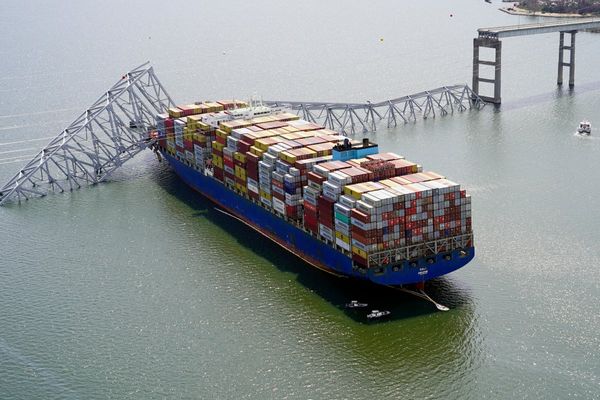
It was dry and sunny in Melbourne 10 days ago when Kimberley Reid was looking at images being spat out by a weather forecasting model – all isobars, arrows and splodges of orange.
The phenomenon forming in the atmosphere off Queensland’s coast – about 1500 kilometres (930 miles) north-east of Reid’s computer screen – was nothing remarkable yet, but the channels of moisture she saw in the pictures are the subject of her PhD.
“Atmospheric rivers are quite easy to see,” she says. “I thought it didn’t look that strong. I was holding back from tweeting. I didn’t think it was going to get that big.”
A few days later, the river got stuck over an area of the Pacific Ocean a few hundred kilometres north of Brisbane.
Rain became torrential – like a tsunami from the sky. Politicians called it a “rain bomb”.
Towns and cities – tens of thousands of homes and businesses, as well as bridges, roads and dreams – went under water, leaving Australians wondering if they’d been smashed once more by the climate emergency.
Rivers in the sky
There were other things happening around the river that Reid saw on the computer weather model.
The Bureau of Meteorology says a cold weather system in the upper atmosphere – between eight and 10 kilometres up – had moved north from waters to the south of the continent and was mixing with warmer air from the tropics.
An area of low pressure – known as a trough – formed in the Coral Sea, causing moist air to be lifted up, condense and then fall as rain.
Usually systems like this pass through and out over the ocean, but the bureau says another atmospheric phenomenon – an area of high pressure much further east – acted as a block. Now all that was needed was the winds that pushed all that moisture over Queensland’s south-east.
Reid says atmospheric rivers are long, narrow regions between one and three kilometres up “characterised by really strong water flow. It is like a running river in the sky.”
Reid has calculated how much water was in the river as it was flowing over Greater Brisbane.
The city itself got almost 80% of its annual rainfall in only six days up to 28 February, when the system started to move south. Brisbane had only ever recorded eight days of more than 200mm before the 2022 floods. But it saw three in a row.
Reid says over the course of the two heaviest days of rain, 26 and 27 February, enough water flowed in the atmospheric river above the city to fill Sydney harbour – that holds about 500bn litres – almost 16 times.
Reid wants to know how these atmospheric rivers could be influenced by global heating. She thinks these systems could move south along Australia’s east coast and when they do occur, “there’s more moisture in the atmosphere and they’re going to be quite intense.”
Reid’s research has looked at an atmospheric river that caused flooding over Sydney in March 2021. “I’ve found that over Sydney, the frequency of these long duration events will increase by 80% by the end of this century,” she says.
Atmospheric rivers are under-studied in Australia and her university seniors think she is the first to do a PhD on them.
“In the US they fly aeroplanes through them. Here, it’s mostly me doing [the research],” she says.
Weather on steroids
The unprecedented flooding that raised many rivers above record highs moved south, leaving towns underwater.
Residents in parts of western Sydney were told to evacuate for the second year in a row as the city’s Warragamba Dam overflowed. But the system stalled before it passed over Sydney.
But the bureau added the combination of atmospheric events was “not unusual in itself.”
Australia’s east coast was already wet. A La Niña had pushed warmer ocean water closer to the continent’s east, increasing cloud and rain. So why did it rain so much?
The event has seen a flurry of communications between scientists this week, discussing plans to launch different studies to understand what role a changed climate could have had.
Burning coal, oil and gas and chopping down forests has loaded the atmosphere with extra greenhouse gases, causing heating. There is now 50% more CO2 in the atmosphere than before the Industrial Revolution. Australia has warmed by 1.4C since 1910.
“We’ve added steroids to the climate system that have amplified the rainfall,” says Prof David Karoly, a veteran Australian climate scientist based at the University of Melbourne.
While it’s known the atmosphere can hold 7% more moisture for every degree of warming, Karoly explains the extra CO2 could have played several roles.
As the moisture condenses into rain droplets, energy is released in the form of heat. Karoly says this sets off a feedback cycle in the atmosphere that amplifies the uplift from the oceans, which are also warmer than they used to be. So the extra 7% could, in real terms, add more than that in rainfall – in some cases more than double, he says.
“These weather systems have occurred in the past. But now we have a hotter ocean and a hotter atmosphere and the feedback can give you much bigger rainfall events,” he says.
Dr Andrew King, also at the University of Melbourne – a main centre for climate studies in Australia – says scientists will look at what happened from multiple angles.
“There’s a thermodynamic part – the moisture – and with that it’s easier to say climate change has enhanced that a bit.
“But you also need the lifting motion that produced the rainfall and that is so much more complicated. We don’t fully understand how these weather systems are changing.
“Fundamentally, we have altered the planet a huge amount. Every event that occurs in our altered system would look different if we hadn’t done that.”
Brisbane’s last major flood was 2011. The city’s river swelled and engulfed suburbs. The images and footage were seen around the world.
Mathematician Dr Kate Saunders was living in one of those suburbs. That extreme event was the catalyst for a decade of study into “extreme value theory” – a way to understand things that have never been witnessed. She’s applying that to extreme rainfall using climate models.
Saunders left Brisbane to study after the 2011 floods, via CSIRO and the University of Melbourne, and is now back in her home city at QUT in time to witness another tragedy.
“What’s really challenging from a statistical perspective is you only have about 110 years of data. But if that climate signal is only becoming stronger, then you’re getting more risk.
“For example, how many times have we had to evacuate Brisbane and parts of Sydney in the same week? When you look at how widespread this was, it makes it an outlier in our records.”
As the rain fell over Brisbane, houses, parks and $1m mansions around her street went under. This was going to generate a flood of scientific inquiry.
“I thought – uh, oh. There’s a lot of work coming here.”







